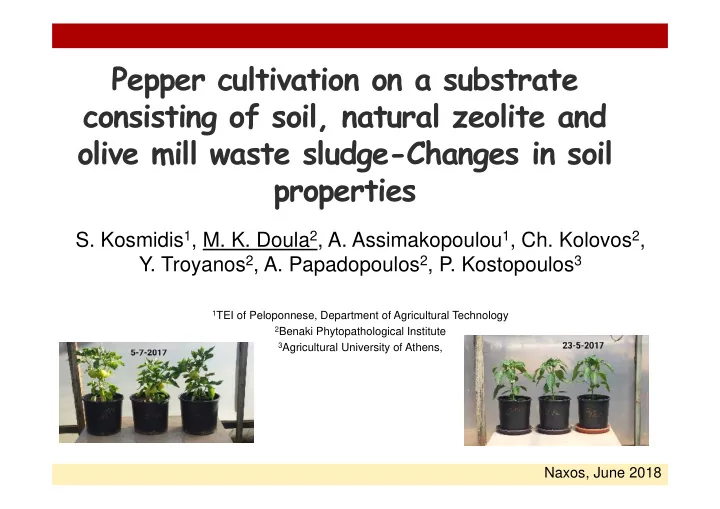

Pepper cultivation on a substrate consisting of soil, natural zeolite and olive mill waste sludge-Changes in soil properties S. Kosmidis 1 , M. K. Doula 2 , A. Assimakopoulou 1 , Ch. Kolovos 2 , Y. Troyanos 2 , A. Papadopoulos 2 , P. Kostopoulos 3 1 TEI of Peloponnese, Department of Agricultural Technology 2 Benaki Phytopathological Institute 3 Agricultural University of Athens, Naxos, June 2018
Olive Mill Waste Characteristics : • Seasonal production (from November to February) • High water content • High organic load • High content in polyphenols • High electrical conductivity • High content of nutrients (potassium, iron) • High oil content Management of olive mill wastes: • Disposal in evaporation ponds • Disposal on soils and on water recipients • Treatment in special installations (production of soil improvers, use in the irrigation of the treated liquid part) • Treatment and retrieval of phenols
OMW : Uncontrolled disposal on soils LIFE PROSODOL Olive wastes on soil • pH Electrical Conductivity up to 10 mS/cm • Electrical Conductivity Exchangeable Potassium up to 20 cmol/kg • Organic Matter Available Phosphorus up to 440 ppm • Total Nitrogen Available Iron up to 380 ppm • Available Phosphorus Total Nitrogen up to 20 mg/g • Exchangeable Potassium Polyphenols up to 600 ppm • Polyphenols • Available iron
12 weeks greenhouse experiment Pepper plants in 36 pots Solid Olive Mill Waste 3 doses 0%, 2.5%, 5.0% 3 doses of zeolite (clinoptilolite) 0%, 2.5%, 5.0% 0% ZEOLITE 2.5% ZEOLITE 5.0% ZEOLITE Z0 AP0 Z1 AP0 Z2 AP0 Z0 AP1 Z1 AP1 Z2 AP1 Z0 AP2 Z1 AP2 Z2 AP2 The pepper seedlings were planted in 9 different soil/solid olive mill waste/zeolite mixtures. Ε ach kind of mixture was placed in 4 pots. The experimental design was based on a split ‐ plot pattern. Plants were irrigated every other day by adding 1000ml of water, while leachates, were collected and analyzed weekly. Peppers and pot soils were harvested and collected respectively, for further research and conclusio ns. Naxos, June 2018
12 weeks greenhouse experiment Table 1: OMW properties Parameters Value Organic Matter, % 97 Electrical 2,6 Conductivity, mS/cm pH 4,10 Polyphenols, % 0,32 Nitrogen, % 0,51 Potassium, % 1,1 Calcium, % 0,11 Magnesium, % 0,05 Sodium, % 0,04 Phosphorus, % 0,05 Iron, mg/kg 41 Copper, mg/kg 12 Zinc, mg/kg 4,3
Number of crops harvested 5.0% OMW 6 5 4 3 2 1 0 Z0AP0 Z0AP1 Z0AP2 Z1AP0 Z1AP1 Z1AP2 Z2AP0 Z2AP1 Z2AP2 • By increasing waste dose, the number of crops were increased. The highest waste dose resulted in the highest number of crops • Zeolite seems to affect the number of crops • For no waste case, increased zeolite percentage seems to increase crops number, but….. • Zeolite and waste effect : Delays in crops growth The first crops were harvested with two weeks delay
Επίδραση των μεταχειρίσεων στο νωπό (FWT) και Crops Fresh (FWT) and Dry Weight (DWT) ξηρό βάρος (DWT) των καρπών 100 80 60 40 20 0 Z0AP0 Z0AP1 Z0AP2 Z1AP0 Z1AP1 Z1AP2 Z2AP0 Z2AP1 Z2AP2 FWT DWT
Substrate Organic Matter OM, % Treatments But if only the increased waste amount increases yield, is zeolite necessary?
Potassium in leachates WEEKS With 0% zeolite: increased leaching as waste dose increases As zeolite dose is increasing, leaching is inhibited, therefore Prevent leaching of nutrients 1. Keep nutrients in soil 2. WEEKS
Exchangeable Potassium in the substrate K, cmol/kg K, cmol/kg Treatments Treatments
Substrate Electrical Conductivity …but this results to higher substrate EC EC, mS/cm Treatments
Electrical Conductivity, mS/cm WEEKS Although effects of waste and zeolite doses can be seen, in general the EC of the leachates are considered low …. ..and also in comparison with what is happening when fertilizers are added on soils!!! WEEKS
Treatments B, mg/kg Boron in Substrates
Avalable Fe in Substrates Fe, mg/kg Treatments
WEEKS High Na concentrations released mainly during the first 3 weeks, which then reduced. It is due to zeolite, and increases as zeolite dose Increases. However, ESP remains < 6 (no salinity risk) …but it affects production (e.g. Delays, WEEKS less crops) (Na 0.2 K 0.6 Mg 0.7 Ca 2.0 Al 6.2 Si2 9.8 O 72 .19.6H 2 O
Sodium in Substrates Na, cmol/kg Treatments • Organic matter of OMW increases the number of crops harvested and also the fresh and dry weight of the crops • Zeolite prevent leaching of potassium and keep K in the substrate • The EC of the substrate increases but t s not considered riksy for the 2.5% of zeolite and waste • It is necessary to foresee a period of 2 ‐ 3 weeks to wash Na from the substrate • Compared to fertilization, the substrate used produced leachates with significant lower Electrical conductivity • Because of the high Na content, the increased EC of soil and substrate, the delays in crop growth , the case of Z1AP1 or Z1AP2 (?) seem to be more appropriate, but measurements in crops are still in progress……
Thank you for your attention Dr. Maria K. Doula Benaki Phytopathological Institute Greece
Recommend
More recommend